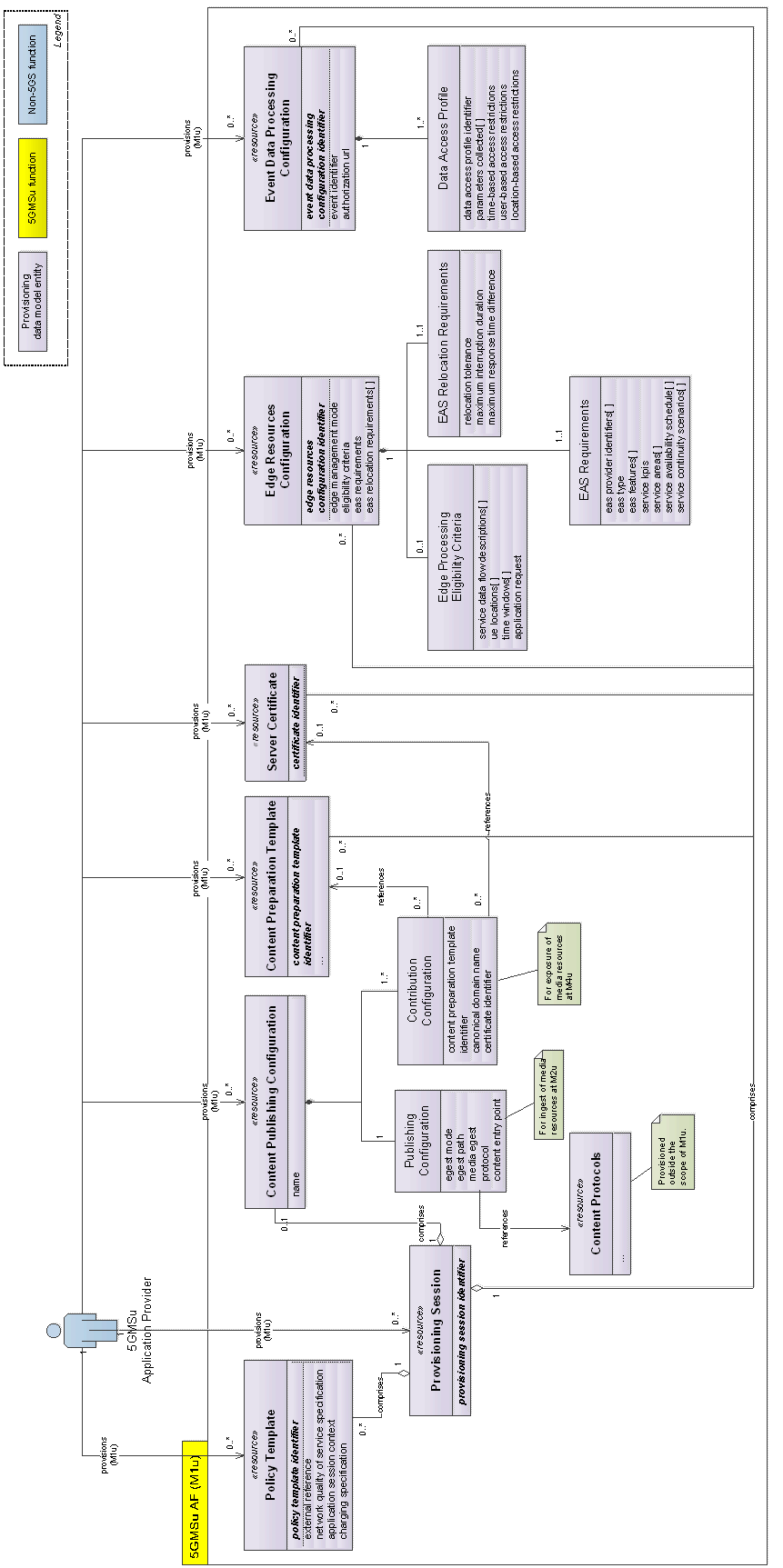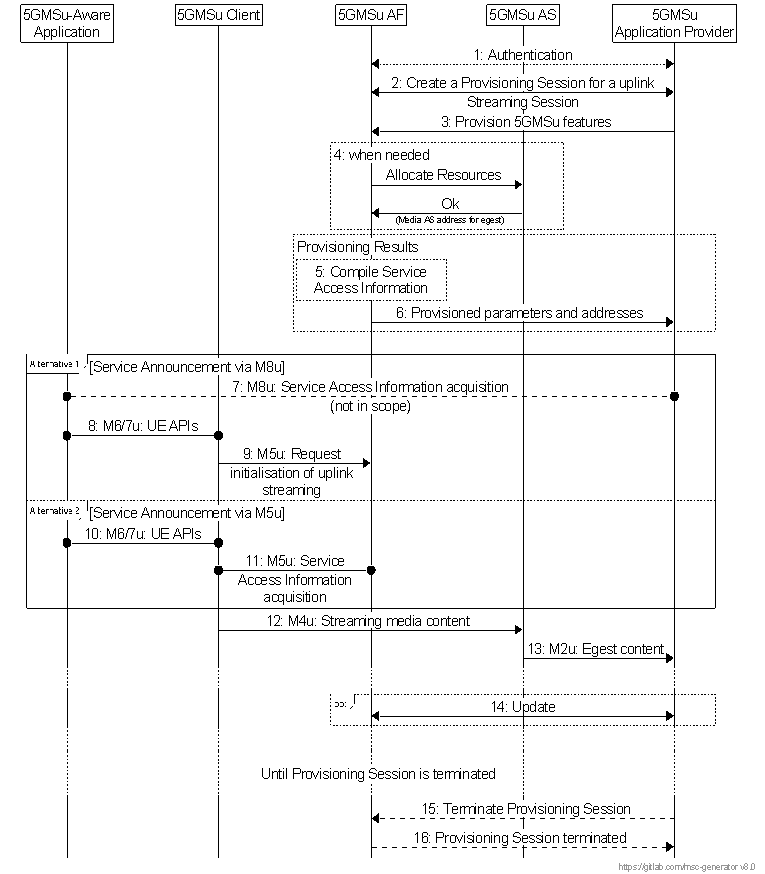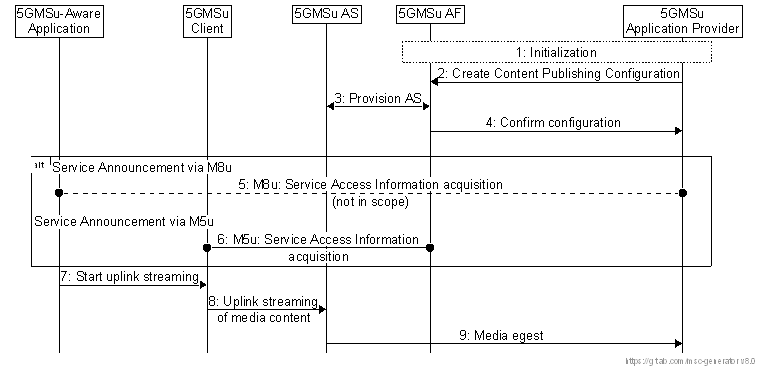Content for TS 26.501 Word version: 18.0.0
1…
4…
4.2…
4.2.2…
4.3…
4.5…
4.6…
4.7…
5…
5.2…
5.3…
5.3.2
5.4…
5.5…
5.5.3…
5.6…
5.7…
5.7.3
5.7.4…
5.8
5.9…
5.10…
5.10.5
5.10.6
5.11…
6…
6.2…
6.3…
6.5…
6.8…
7…
8…
8.2
A…
A.3…
A.5…
A.7…
A.9
A.10
A.11
A.12
A.13
A.14
A.15
B…
B.3
C…
C.3
C.4
C.5
D…
6.2 Preparing for Uplink Media Streaming
6.2.1 Introduction
6.2.2 Provisioning session for uplink streaming
6.2.2.1 Domain model
6.2.2.2 Baseline provisioning procedure
6.2.3 Content Publishing Configuration for Uplink Streaming
6.2.3.1 General
6.2.3.2 Media egest procedure
...
...
6.2 Preparing for Uplink Media Streaming p. 87
6.2.1 Introduction p. 87
Before streaming media data in the uplink direction, a set of parameters are provisioned at the 5GMSu AF/AS and at the 5GMSu Client. On the 5GMSu AF/AS, the M1u API is used for session provisioning. On the UE side, the M8u or M5u API is used for provisioning.
6.2.2 Provisioning session for uplink streaming p. 87
6.2.2.1 Domain model |R18| p. 87
The M1u baseline domain model is depicted in Figure 6.2.2.1-1 overleaf. It consists of a Provisioning Session, which contains at least one of the following:
- A Content Publishing Configuration,
- A Policy Template,
- One or more Content Preparation Templates,
- An Edge Resources Configuration specifying the requirements for edge processing as defined in TS 23.548 and TS 23.558 in support of the Provisioning Session, including eligibility criteria that indicate the circumstances in which edge computing is to be used for Media Streaming sessions associated with this Provisioning Session and parameters indicating the tolerance of the application for relocation of the Edge AS, or

6.2.2.2 Baseline provisioning procedure |R18| p. 89
This clause describes the baseline procedure to provision the features using the 5GMS System.

Figure 6.2.2.2-1: High Level Procedure for provisioning the 5GMS System for uplink streaming sessions
(⇒ copy of original 3GPP image)
(⇒ copy of original 3GPP image)
Steps:
Step 1.
The 5GMSu Application Provider authenticates itself with the system. This procedure reuses existing authentication/authorization procedures, e.g. as defined for CAPIF [13].
Step 2.
The 5GMSu Application Provider creates a Provisioning Session, providing its 5GMSu Application Provider identifier as input. 5GMSu Application Provider queries the capabilities and authorized features.
v3. The 5GMSuApplication Provider specifies one or more 5GMSu features in the Provisioning Session. A set of authorized features is activated, such as content dynamic policy; network assistance; and content publishing (including egest).
When the content publishing feature is offered and selected, the 5GMS Application Provider configures the content publishing behaviour of the 5GMSu AS, including selecting the uplink ingest protocol and format, content preparation and egest protocol and format.
When the dynamic policy feature is offered and selected, the 5GMSu Application Provider specifies a set of policies which can be invoked for the uplink streaming session. The UE becomes aware of the selected policies in the form of a list of valid Policy Template Ids.
When the edge computing feature is offered and selected, the 5GMSu Application Provider provides one or more Edge Resources Configurations that can be used to support either client-driven management or Application Provider-driven management of edge resources associated with the Provisioning Session.
Step 4.
When content publication is desired, the 5GMSu AF interacts with the 5GMSu AS to allocate resources for M2u egest protocol and format. Then the 5GMSu AS responds to the 5GMSu AF with the M2u content egest address.
Step 5.
The 5GMSu AF compiles the Service Access Information. The Service Access Information contains access details and options such as the Provisioning Session identifier, M5u (Media Session Handling) addresses for uplink entry point, dynamic policy, network assistance, etc.
Step 6.
The 5GMSu AF provides the results to the 5GMSu Application Provider.
The following steps:
Step 7.
When the 5GMSu Application Provider has selected full Service Access Information, the results are provided in the form of addresses and configurations for M2u (content egest), M5u (Media Session Handling) and M4u (Media Uplink Streaming). The 5GMSu Application Provider provides a subset of this information to the 5GMSu-Aware Application through M8u.
Step 8.
When the 5GMSu-Aware Application decides to activate the streaming service transmission, the Service Access Information is provided to the 5GMSu Client.
Step 9.
The 5GMSu Client requests the 5GMSu AF to initialise uplink media streaming (M5u), including reservation of any resources required for content preparation.
Or, alternatively:
Step 10.
The 5GMS-Aware Application requests the 5GMSu Client to start an uplink streaming session (M6u/M7u).
Step 11.
When the 5GMSu Application Provider has delegated Service Access Information handling to the 5GMS System, a reference to the Service Access Information (e.g. an URL) is provided. The Media Session Handler fetches the full Service Access Information later from the 5GMSu AF.
Then:
Optionally:
Step 14.
The 5GMSu Application Provider may update the Provisioning Session.
According to schedule, or upon request by the 5GMSu-Aware Application:
Step 15.
The 5GMSu Application Provider may manually terminate the Provisioning Session (at any time). All associated resources are released. Content may be removed from the 5GMSu AS. The 5GMSd Application Provider may configure a schedule for Provisioning Session termination.
Step 16.
The 5GMSu AF sends a notification to the 5GMSu Client upon Provisioning Session termination.
6.2.3 Content Publishing Configuration for Uplink Streaming p. 91
6.2.3.1 General |R18| p. 91
The 5G Media Streaming architecture defines a reference point (M1u) for provisioning which offers the procedures to configure content egest for uplink media streaming over a 5GMS System. Once a Provisioning Session is established using the API at reference point M1u, content publishing may be configured. Content can then be uplink streamed by the Media Streamer in the 5GMSu Client to the 5GMSu AS through reference point M4u. The uploaded (and possibly processed) content is accessible via reference point M2u for egest.
Reference point M2u supports the egest of the following types of content:
- Live streaming content.
- On-demand streaming content. i.e. the content that previously streamed from the UE to 5GMSu AS and is stored in 5GMSu AS.
- Static files such as images, scene descriptions, etc. associated with the uplink streaming content.
6.2.3.2 Media egest procedure |R18| p. 91
The media egest procedure is as follows:

The steps are as follows:
Step 1.
One of the following steps:
Initialization: the 5GMSu Application Provider discovers the M1u endpoint address and authenticates itself with the 5GMSu AF.
Step 2.
Create Content Publishing Configuration: the 5GMSu Application Provider creates a new Content Publishing Configuration through the 5GMSu AF. The configuration specifies path, protocol, entry point, the egest push/pull mode, and possibly one or more content preparation templates. Upon successful configuration, the 5GMSu AF responds with a Content Publishing Configuration identifier, and the location of the 5GMSu AS from which to pull the content (if using the pull mode).
Step 3.
Provision 5GMSu AS instance(s): The 5GMSu AF configures the related 5GMSu AS instance(s) for a particular Content Publishing Configuration. This step may involve instructing the 5GMSu AS to establish one or more content preparation processes. The 5GMSu AS(s) responds whether the configuration was successful or not.
Step 4.
Confirm provisioning: Upon successful provisioning, the 5GMSu AF responds with a Content Publishing Configuration identifier, and the location of the 5GMSu AS from which to pull the content (if using the pull mode).
Step 5.
or:
Provide the uplink entry point: The 5GMSu Application Provider publishes the uplink entry point to the 5GMSu-Aware Application through reference point M8u to enable it to begin uplink streaming to the 5GMSu AS.
Step 6.
The 5GMSu Application Provider may update a Content Publishing Configuration subsequently to modify some of its parameters. The subset of parameters that can be updated may be limited by the 5GMSu AF.
The 5GMSu Client acquires the uplink entry point as part of Service Access Information through reference point M5u.
Step 7.
The 5GMSu-Aware Application requests the 5GMSu Client to start the uplink streaming.
Step 8.
The 5GMSu Client starts uplink streaming of the content to the 5GMSu AS via reference point M4u.
Step 9.
Media egest: The 5GMSu Application Provider may start pulling or receiving content (if using push mode) from the 5GMSu AS. The 5GMSu AS performs the requested content preparation prior to making the uplink content ready for being pulled by or pushed to the 5GMSu Application Provider.